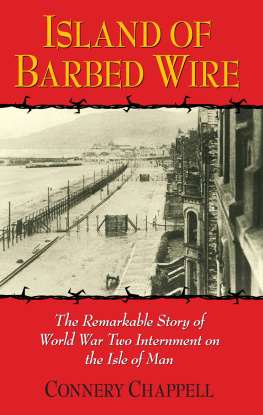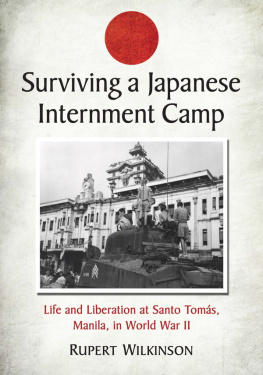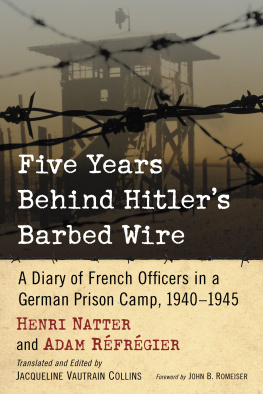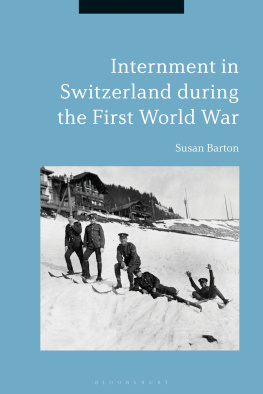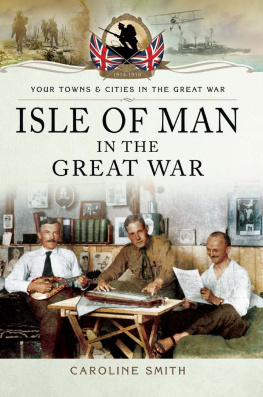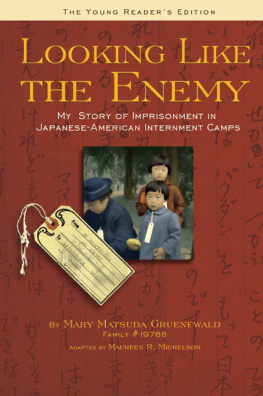ISLAND OF BARBED WIRE
Other books by Connery Chappell
FICTION
Swinging Apple
Two Pleasures for your Choosing
The Arrival of Master Jinks
Trouble on the Line
NON-FICTION
Island Lifeline
The Dumbell Affair
Island of
Barbed Wire
Internment on the Isle of Man
in World War Two
CONNERY CHAPPELL
Foreword by
Sir Charles Kerruish KBE, OBE

ROBERT HALE
First published in 1984
Paperback edition published in 2005 by
Robert Hale, an imprint of The Crowood Press Ltd,
Ramsbury, Marlborough, Wiltshire SN8 2HR
www.crowood.com
www.halebooks.com
This impression 2017
This e-book first published in 2017
Connery Chappell 1984
All rights reserved. No part of this publication may be reproduced or transmitted in any form or by any means, electronic or mechanical, including photocopy, recording, or any information storage and retrieval system, without permission in writing from the publishers.
British Library Cataloguing-in-Publication Data
A catalogue record for this book is available from the British Library.
ISBN 978 0 71982 443 2
The right of Connery Chappell to be identified as the author of this work has been asserted by him in accordance with the Copyright, Designs and Patents Act 1988.
Contents
List of Illustrations
Between chapters 7 & 8
The seaside boundary of the Mooragh Camp, Ramsey
Inside the barbed wire of the Mooragh Camp
Metropole Camp on the Loch Promenade, Douglas
Falcon Cliff Hotel, above Douglas, formerly the internees hospital
Internees returning to camp under escort
Coupon money used in the internment camps
Chief Inspector Ogden
C. R. M. Cuthbert
Professor Gerhard Bersu with a local farmer
Portrait of Fred Uhlman by Kurt Schwitters
Christmas and Chanukah cards made by Onchans first internees
Two issues of the Onchan Pioneer
Royal Avenue, Onchan as depicted in the Onchan Pioneer, 1940 and as seen today
Between chapters 18 & 19
17 Peveril Road today
Todays view from 17 Peveril Road
and its view of the guardhouse during the war
The escape tunnel from Peveril Camp
The ten-foot descent into the tunnel
Forged US naval passes on two internees who were caught
Illustrations are reproduced by courtesy of the following: 3, 5, 12B, Hilary Guard Collection; 4, 13B, 14, 15, Stanley Basnett; 69, coupon money photos, 6, by Edward J. Kelly from the Leslie Morgan Collection; 10, Department of Fine Art, University of Newcastle.
Foreword by Sir Charles Kerruish, KBE, OBE
Former Speaker of the House of Keys
From the dawn of history the Isle of Man has been subject to the arrival of visitorssome of these visits have been unwelcome, as were the invasions of marauding Norsemen in the ninth and tenth centuries. More recently the Isle of Man has made a virtue of necessity by seeking, not unsuccessfully, to attract to its shores visitors of another sort, holiday-makers.
This book chronicles a remarkable visitationthe alien internees, and later the political detainees who, although not in arms, were regarded as threats to the security of a country engaged in a war for survival. Some of these arrivals were hostile but more were confused, puzzled, and many resentful of the fact that they were regarded as being potentially dangerous by a country they felt was home and whose cause they espoused.
They came to an island which, although only a hundred miles from places which felt the full fury of Hitlers onslaught, was remarkably insulated against the trauma of war. It was an island whose population had for the second time responded to the call to defend the free world, sending a higher percentage of its young men and women to the war than any other part of the British Islands. It was an island which was temporary home for up to 10,000 servicemen at any one time throughout the hostilities, an island which shared the concern of its neighbour across the water over the future, and the ultimate result of the war.
Connery Chappell treats this fascinating period of the Isle of Mans history with great sensitivity. He portrays the pathos of families separated by the winds of war, human frailty, natural suspicion on the part of a population at war, the frustration of individuals at bureaucratic delays and, above all, the response of the internees which resulted in some cases in despair, in some cases in anger, in many cases in boredom, but in so many cases in the profitable use of time for self-improvement. When one considers the variety of their origin and background it is perhaps not surprising that so many men of ability passed through the Isle of Man. They were to use that time of enforced experience to exchange ideas, increase their knowledge and better equip themselves to contribute to the society to which they would ultimately return, and in many cases to achieve great eminence in their respective fields.
This book helps Manx people, the men and women who found the Isle of Man as a temporary home, and all students of the human condition to understand more fully this phase of Island history.
Acknowledgements and Sources
Much has been lost of the great mass of paperwork that a World War must have left behind in the Isle of Man. Demolition and rebuilding saw the shredding or disposal of many files, and Manx lore insists that much of the islands modern social history lies at the bottom of a disused mine working, where local officialdom tended years ago to dump its papers. Since then order has been restored.
However, the archives in the library of the Manx Museum, and to a lesser extent in the attics of Douglas, still make possible a reconstruction of life on the island as it was affected by the internment camps that mushroomed up in 1940; to do this the writer has been given access to old papers of a general nature for which he is indebted to Peter Hulme, the Manx Government Secretary, and to Frank Weedon, Chief Constable. Thanks are also due to A. Marshall Cubbon, Director of the Manx Museum, and to invaluable help from Ann Harrison, Archivist and Librarian of the Museum Library.
Alan Killip, now Superintendent and Deputy Chief Constable was a police cadet at the time and gave the writer valuable help, as did R. L. Lamming FRCS and Dr Alexander McPherson; Major Edward Brownsdon, and Sydney Shimmin, respectively Life President and Managing Director of the Isle of Man Steam Packet, who enabled a search to be made of the lines sailing-sheets; Barnet Fingerhut, who helped compile details of the Jewish internees who died on the island during the war; Rev. Denis Baggaley; J. A. Bregazzi; Mrs Millicent Faragher; Harvey Briggs; M. Moore and Mrs K. McNeil, among others.
Executives of specialized organizations who dealt with wartime internment and who contributed advice or gave material that was used in compiling the book, included David Massel, Executive Director of The Board of Deputies of British Jews; Dr Werner Rosenstock, Association of Jewish Refugees in Great Britain; Joan Stiebel, Jewish Refugees Committee; Miss M. N. Slade, Archivist, British Red Cross Society; Major E. R. Elliott, Corps Secretary, The Royal Pioneer Corps; J.-J. Indermhle, Cultural Counsellor, Swiss Embassy, London; Library of the Religious Society of Friends, London; Library of the Ministry of Agriculture, Fisheries and Food, London; and Library of the Ministry of Defence, London.
Local people on the Isle of Man to whom thanks are due include Mrs E. W. H. Kellett; R. J. Kermeen; the late Alec Clague; Mrs Joan Herring; Walter Kennedy; Mrs E. McGhee; Ken Powell; W. E. Curphey; Leonard Fletcher; D. F. Goodyear; A, Fehle; R. D. Quine; Maurice and Mrs Scales; Egerton Cregeen and the late Mrs Cregeen; Albert Lowe; W. E. Cowley; E. Corteen; and J. G. Bell.
Next page
